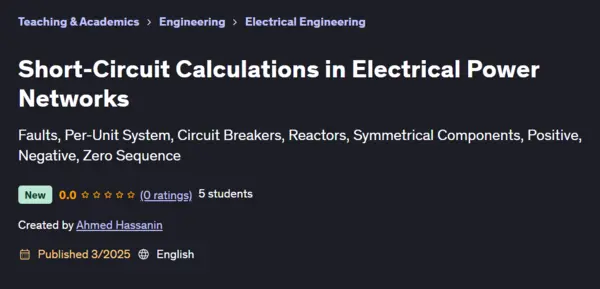
Free Download Udemy - Short-Circuit Calculations in Electrical Power Networks
Published: 3/2025
Created by: Ahmed Hassanin
MP4 | Video: h264, 1280x720 | Audio: AAC, 44.1 KHz, 2 Ch
Level: All | Genre: eLearning | Language: English | Duration: 39 Lectures ( 3h 5m ) | Size: 1.2 GB
Faults, Per-Unit System, Circuit Breakers, Reactors, Symmetrical Components, Positive, Negative, Zero Sequence
What you'll learn
Types of Electrical Faults
Importance of Short-Circuit Calculations
Equivalent Circuit Assumptions
Sources of Short-Circuit Current Supply (Local Generators, Synchronous Motors and Capacitors, Induction Motors)
Asymmetry in Short-Circuit Currents
Per-Unit System
Rated Currents of Circuit Breakers
Current Limiting Reactors (Generator Reactor, Feeder Reactors, Busbar Reactors)
Motor Starting
Ground Fault and Neutral Point
Difference between Neutral Point and Earth Point
Symmetrical Components
Zero-Sequence Current VS Neutral C, AC or DC current?
Sequence Impedances of Generators, Transformers, and Overhead Lines and Cables
Zero-Sequence Networks
Double-Line-to-Ground S.C
Requirements
Electrical Engineer, Calculator, PDF Reader, Office Program
Description
Through my practical experience (22 years) in the field of electrical substations for medium voltage (MV), high voltage (HV), and extra-high voltage (EHV), as well as working with various consulting offices in designing electrical distribution networks for many important projects that require accuracy in various electrical calculations, in addition to obtaining a Master's degree in Engineering Sciences in Power and Electrical Machines Engineering titled "Detection and Identification of Power Quality Problems using advanced Artificial Intelligence techniques (LSTM)", this course and these very important questions were prepared using the best engineering programs that connect academic/theoretical aspects with practical/reality in high voltage and extra-high voltage electrical substations, as well as distribution networks for medium and low voltages.This unique approach to explanation and question preparation has been designed to cater to all engineering and technical levels, starting from students in engineering universities and various technical institutes, all the way to highly experienced specialized engineers in power systems and electrical distribution.The course has been explained in a practical manner, relying on simplicity in theoretical explanations and placing greater emphasis on visuals and real-life practical examples. This approach allows us to connect academic theoretical study with what actually exists in practical reality for real-world application after completing this course.The course we have is closely related to the power systems and electrical distribution systems. In this course, we provide the following:Short-Circuit Current Calculations in Electrical Power Networks* The basics of short-circuit current calculations in electrical power networks.* The types of electrical faults that can occur in the electrical network.* differentiate between symmetrical and unsymmetrical faults.* The importance of short-circuit current calculations and the key factors that influence them* discuss the assumptions used in constructing the equivalent circuit of the electrical network during a short-circuit condition* The sources of short-circuit current supply (utility system, local generators, synchronous motors and capacitors, induction motors)* How we can calculate the asymmetric short-circuit currents* The importance of using the Per-Unit System in electrical network calculations instead of using actual quantities* The Rated Currents of Circuit Breakers* The Current limiting reactors (generator reactor, feeder reactors, busbar reactors,* Motor starting* The role of the neutral point in determining the behavior of the electrical network during a ground fault* The difference between the neutral point (N), and the Ground point or the earth point (E).* The Symmetrical Components theory* The difference between Positive Sequence, Negative Sequence, and Zero Sequence.* The difference between the zero-sequence current and the neutral current.* Is the zero-sequence current AC or DC?* The positive-sequence current, negative-sequence current, and especially the zero-sequence current in star and delta connections.* Sequence impedances (generators, transformers, overhead transmission lines and cables)
Who this course is for
Engineering college students and students of technical institutes. Engineers and technicians working in power stations and distribution networks. Specialists involved in the study and mitigation of short-circuit currents in electrical power networks.
Homepage:
Code:
Bitte
Anmelden
oder
Registrieren
um Code Inhalt zu sehen!
Recommend Download Link Hight Speed | Please Say Thanks Keep Topic Live
Code:
Bitte
Anmelden
oder
Registrieren
um Code Inhalt zu sehen!